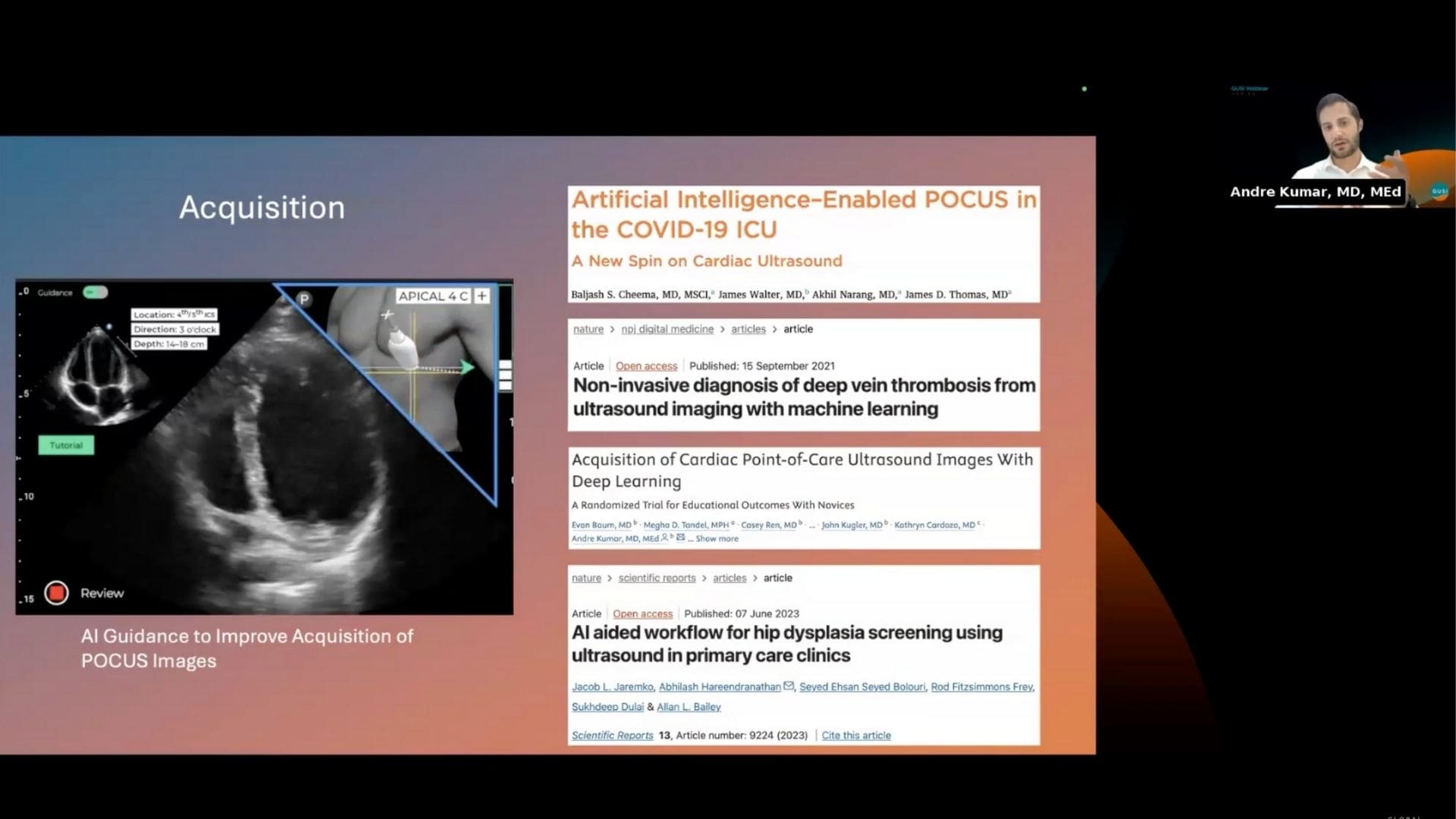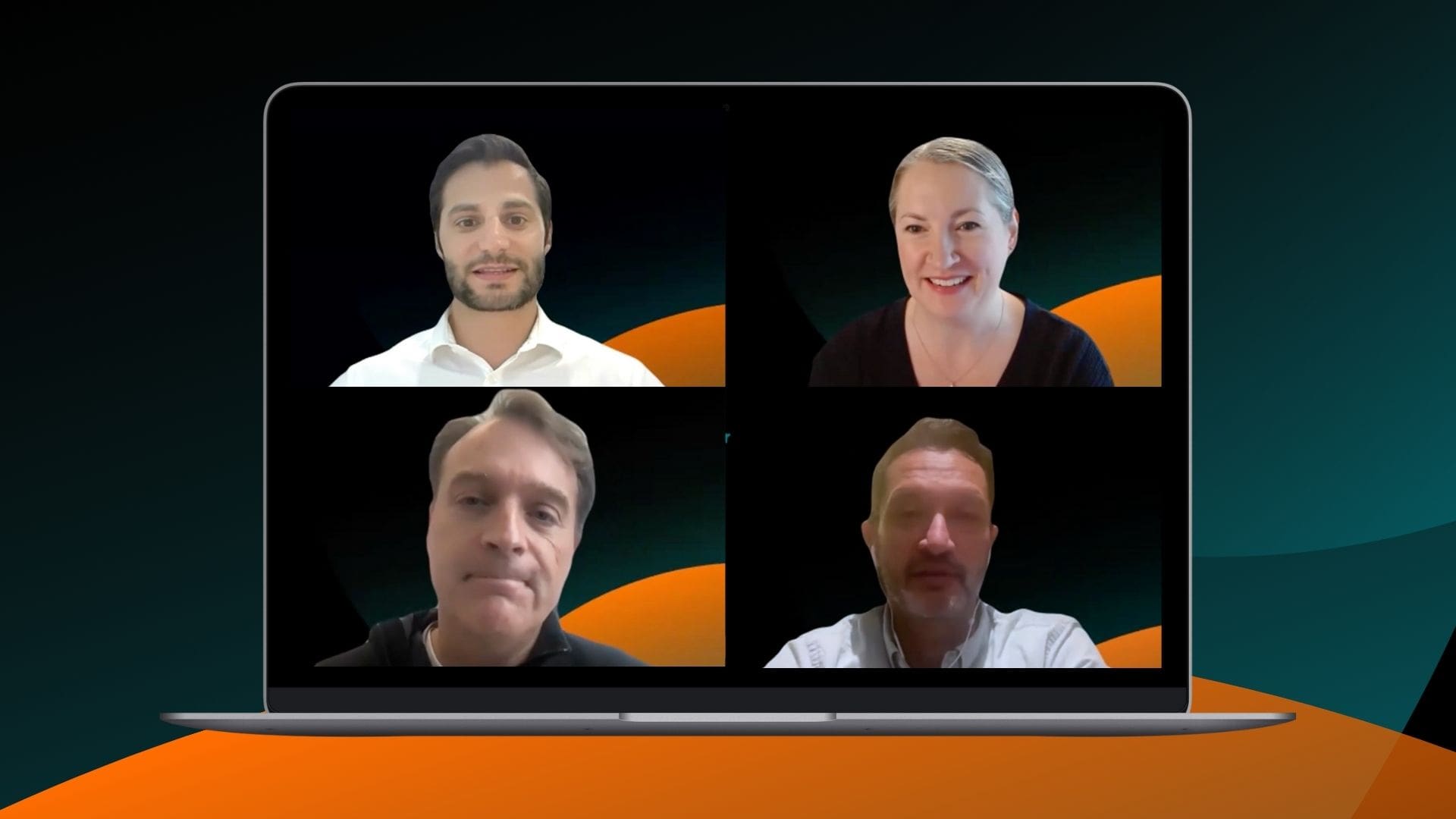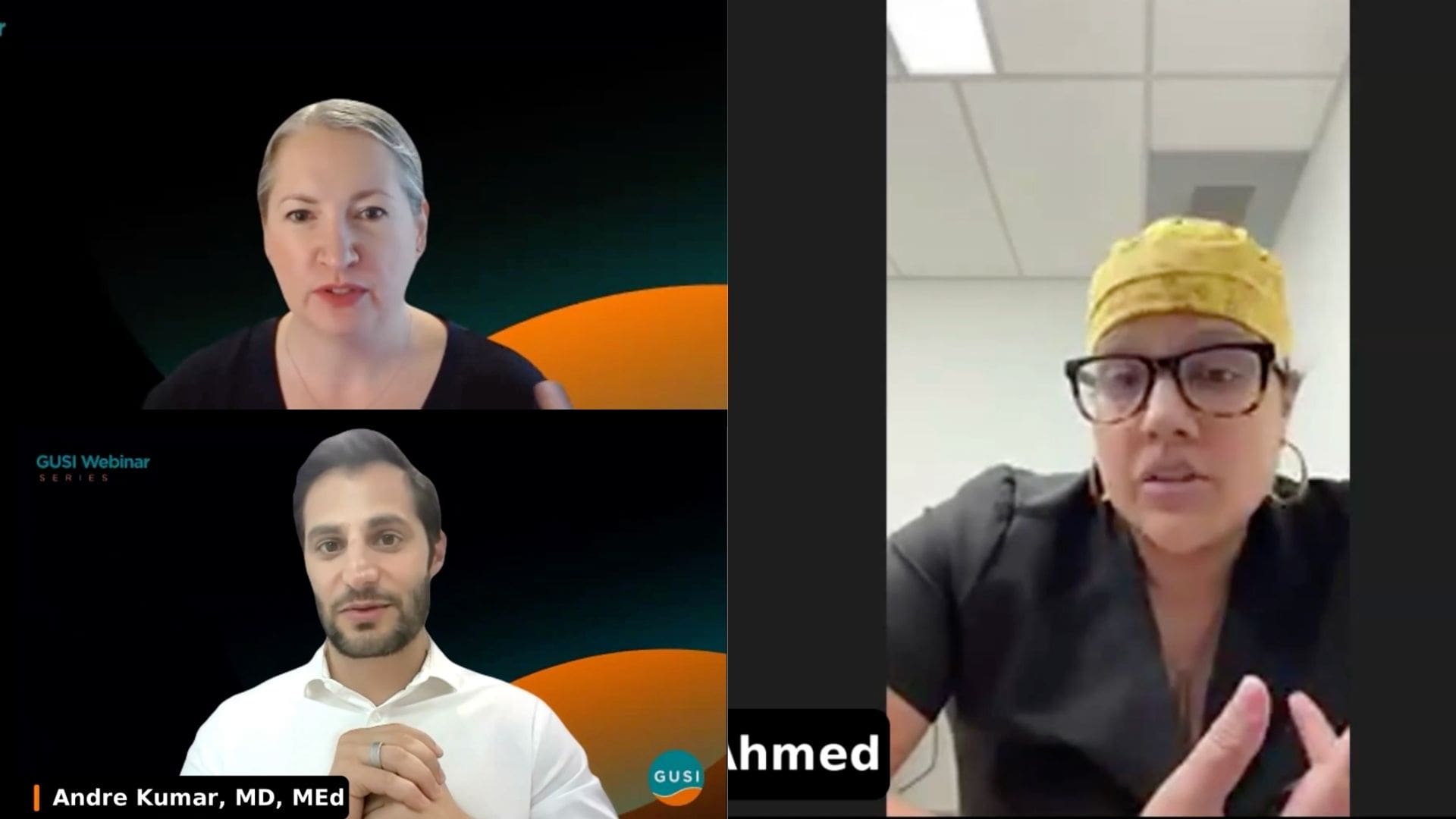Part 1 of a 3-Part Series on Artificial Intelligence in Point-of-Care Ultrasound
Artificial intelligence in point-of-care ultrasound (AI in POCUS) is no longer a distant future. It’s transforming clinical practice today. In a groundbreaking webinar hosted by Dr. Kevin Bergman and Dr. Mena Ramos, co-founders of Global Ultrasound Institute (GUSI), leading experts gathered to discuss how AI is revolutionizing ultrasound acquisition, interpretation, and clinical workflows across healthcare settings worldwide.
“Our mission at GUSI is to enable every healthcare practitioner, regardless of location or resource, to deliver rapid, precise, and often life-saving ultrasound diagnoses at the point of care,” Dr. Bergman explained in his opening remarks. Dr. Ramos emphasized that the webinar series is “driven by a shared goal to build an inclusive POCUS community where clinicians learn from each other and share best practices across specialties and health systems.”
The expert panel featured Dr. Andre Kumar (Stanford University), Dr. Arun Nagdev (ECHO/UCSF), Dr. Rob Ferre (Indiana University), Dr. Renee Dversdal (VAVE Health/OHSU), and Dr. Nahreen Ahmed (University of Pennsylvania), who shared critical insights into where AI in POCUS stands today and where it’s headed tomorrow.
The Explosive Growth of AI in Medical Imaging
The market for AI in POCUS and medical imaging is experiencing unprecedented growth. Dr. Andre Kumar opened the discussion with striking statistics that demonstrate the rapid acceleration of artificial intelligence in point-of-care ultrasound:
“Right now, we are in 2025, and the current market size for AI and medical imaging is around $2 billion. Over the next 10 years, we’re expecting a dramatic increase in that amount, close to about $31 billion by the year of 2034,” Dr. Kumar explained.
The numbers tell a compelling story. FDA submissions for AI and medical devices have more than doubled in just four years. In 2020, there were 114 submissions. By 2024, that number jumped to 235. In 2025, just the first two quarters saw 148 submissions, with expectations approaching 300 by year’s end.
This explosive growth signals a fundamental shift in how clinicians will practice medicine, particularly in diagnostic imaging and point-of-care ultrasound applications.
Three Pillars of AI in POCUS
Dr. Kumar outlined three main categories where artificial intelligence is being integrated into point-of-care ultrasound: acquisition, interpretation, and workflow optimization.
1. AI-Guided Acquisition: Democratizing Ultrasound Skills
AI acquisition tools use neural networks to guide users, including novices and even non-clinical individuals, to obtain optimal ultrasound images. These systems provide real-time feedback, helping users position the probe correctly and capture diagnostic-quality views.
“Acquisition relates to AI guidance to improve the acquisition of POCUS images. We’re thinking of using AI to help novices or even non-clinical individuals acquire point-of-care ultrasound images,” Dr. Kumar noted.
Research has validated AI acquisition assistance across multiple clinical applications, including hip dysplasia screening, cardiac imaging, and deep venous thrombosis detection. Perhaps most notably, these tools have been successfully deployed in non-traditional settings with midwives and community health workers, expanding access to ultrasound diagnostics in resource-limited environments.
2. AI-Powered Interpretation: From Pattern Recognition to Diagnosis
The second pillar focuses on using artificial intelligence to identify anatomical structures, detect pathology, and automate measurements that traditionally required expert training.
Dr. Kumar demonstrated how AI interpretation tools can automatically calculate complex measurements like velocity-time integral (VTI) on cardiac images without requiring users to manually adjust measurement gates. The technology has been particularly well-studied in cardiac and pulmonary applications, with AI systems detecting B-lines for pulmonary edema and other pathological findings.
3. Workflow and Billing Automation: Solving the Documentation Burden
The third category addresses one of the most pressing challenges in POCUS adoption: clinical workflow integration, documentation, and billing optimization.
“Finally, we have workflow and billing, which is using AI to enhance clinical workflows to enhance either clinical billing, quality assurance protocols,” Dr. Kumar explained.
This application of AI in POCUS tackles the administrative burden that often prevents clinicians from fully integrating ultrasound into their practice, automatically generating documentation, suggesting billing codes, and streamlining quality assurance processes.
The Trust Question: Can Clinicians Rely on AI in POCUS?
One of the most critical discussions centered on validation, trust, and the clinical integration of AI ultrasound tools. Dr. Arun Nagdev raised important concerns about how clinicians should evaluate and trust AI-generated interpretations.
Dr. Nagdev emphasized the importance of rigorous validation: “We need to understand how these algorithms were trained, what populations they were validated on, and whether they perform consistently across different clinical settings.”
The panel highlighted a key challenge: many AI tools are developed and validated in controlled research environments but may perform differently in real-world clinical practice, particularly across diverse patient populations and in resource-limited settings.
The Black Box Problem
Dr. Renee Dversdal addressed concerns about “black box” AI systems where clinicians can’t understand how the algorithm reaches its conclusions. This opacity creates hesitation among experienced practitioners who are trained to understand the “why” behind their diagnostic decisions.
“Clinical integration requires transparency,” Dr. Dversdal noted. “Clinicians need to understand not just what the AI is telling them, but how it arrived at that conclusion and what confidence level we should have in that interpretation.”
De-Skilling vs. Up-Skilling: A Critical Debate
A recurring theme throughout the webinar was the tension between AI as a tool for democratizing ultrasound skills versus concerns about de-skilling clinicians who become overly reliant on automated interpretation.
Dr. Rob Ferre acknowledged this concern but argued that the real-world impact might be more nuanced: “I don’t think any physician is going to complain that the machine is going to help me do my work faster. As clinicians, we’re already task-burdened, and asking someone to learn point-of-care ultrasound is another large task to do.”
Dr. Ferre emphasized that workflow improvements represent the “low-hanging fruit” where AI can deliver immediate value without the controversial implications of automated diagnosis. “Whatever I can do to have an AI program make it easier for me to do that is something that is an easy win that no one here is going to complain about,” he said.
However, the panel agreed that maintaining fundamental ultrasound competency remains essential, even as AI tools become more sophisticated. The goal should be augmentation, not replacement, of clinical skills.
Global Health: Where AI in POCUS Can Make the Biggest Impact
The conversation took a powerful turn when discussing AI’s potential to expand access to diagnostic ultrasound in underserved communities, both domestically and internationally.
Dr. Nagdev brought the discussion home with a sobering reminder: “I know we all talk about the role of the village in Kenya, but I think it’s the one and a half hour outside of San Francisco hospital that is still using 30 cc’s per kilogram boluses for sepsis patients… when we get people to integrate this into their care, we’ll change a lot of lives, not even outside the country, but right back home.”
This perspective reframes AI in POCUS not just as a technological advancement but as a tool for addressing healthcare disparities wherever they exist, whether in rural Africa or rural America.
The Ecosystem Approach: Why All Three Pillars Matter
When pressed to identify which of the three AI categories (acquisition, interpretation, or workflow) should be the top priority, Dr. Nahreen Ahmed provided a holistic perspective that resonated with the entire panel.
“Much like a lot of what we do in medicine, it’s a bit of an ecosystem,” Dr. Ahmed explained. “Each component is an important part. The task burden is so high, even more so where resources are limited, and those are not just physical resources, those are human resources.”
Dr. Ahmed highlighted the patient perspective as well: “You have patients that are saying they’re frustrated that they don’t have more FaceTime with us because of the task burden. We want to be able to give our patients more time, and time that’s quality.”
This ecosystem approach recognizes that AI acquisition tools mean nothing without reliable interpretation, and both are undermined if workflow integration makes the technology too cumbersome to use in real clinical settings.
Key Challenges Facing AI in POCUS Adoption
The panel identified several critical barriers that must be addressed for artificial intelligence in point-of-care ultrasound to reach its full potential:
1. Validation Across Diverse Populations
AI algorithms must be trained and validated on diverse patient populations to ensure they perform reliably across different demographics, body types, and clinical presentations.
2. Clinical Context Integration
An ultrasound finding means different things in different clinical contexts. AI systems must account for this contextual variation rather than providing one-size-fits-all interpretations.
3. Regulatory Frameworks
As FDA submissions for AI medical devices accelerate, regulatory frameworks must balance innovation with patient safety, ensuring thorough validation without stifling development.
4. Training and Education
Clinicians need education not just on how to use AI tools, but on how to critically evaluate their outputs, understand their limitations, and maintain underlying ultrasound competency.
5. Infrastructure and Integration
Healthcare systems need the technical infrastructure to support AI tools, and these systems must integrate seamlessly with existing EHR and PACS workflows.
The Co-Design Imperative: AI For Us, By Us
Dr. Mena Ramos, co-founder of GUSI, concluded the webinar with a powerful call to action about the future of AI in POCUS development:
“I think as a call to action, bringing the voices at the table where we’re discussing how can AI be useful in this or that setting. We need those voices represented to be part of the co-design, not only to build trust, but to co-develop systems and tools that will not only be adopted, but continuously be improved over time.”
This emphasis on clinician involvement in AI development represents a critical shift from technology-driven innovation to clinician-driven solutions. Rather than asking clinicians to adapt to AI tools designed by engineers, the future lies in collaborative development that centers clinical needs and real-world workflows.

What Comes Next: The Future of AI in Point-of-Care Ultrasound
As this first webinar in GUSI’s three-part series concluded, several themes emerged that will shape the future of artificial intelligence in point-of-care ultrasound:
Hybrid Intelligence: The most promising future likely involves combining AI capabilities with human expertise rather than replacing one with the other. AI handles pattern recognition, automation, and workflow optimization, while clinicians provide clinical context, critical thinking, and patient-centered care.
Personalized Medicine: As AI systems become more sophisticated, they may enable truly personalized diagnostic protocols that adapt to individual patient characteristics, clinical presentations, and healthcare settings.
Continuous Learning: Future AI in POCUS systems will likely incorporate continuous learning mechanisms, improving their performance over time based on real-world clinical data and outcomes.
Democratized Access: Perhaps most importantly, AI has the potential to democratize access to diagnostic ultrasound, bringing advanced imaging capabilities to underserved populations worldwide.
Join the Conversation
This groundbreaking discussion represents just the beginning of an ongoing conversation about artificial intelligence in point-of-care ultrasound. As Dr. Ramos noted, “There are a couple of themes that came out: clinical integration, trust, expertise, and something I want to end with is thinking about how AI can be not just for us, but by us.”
This is Part 1 of GUSI’s 3-part webinar series on AI and POCUS. Stay tuned for future sessions that will dive deeper into specific applications, case studies, and emerging technologies in this rapidly evolving field.
The future of AI in POCUS is not about replacing clinicians. It’s about empowering them with tools that enhance their capabilities, streamline their workflows, and ultimately improve patient care across all healthcare settings.
About the Expert Panel
Dr. Andre Kumar, MD, MEd – Clinical Associate Professor, Stanford Division of Hospital Medicine. Nationally recognized leader in POCUS, medical education, and AI in healthcare applications.
Dr. Arun Nagdev, MD – Vice President of Clinical Education at ECHO, Director of Emergency Ultrasound at Highland Hospital, and Clinical Associate Professor of Emergency Medicine at UCSF. Over 90 peer-reviewed publications on ultrasound applications.
Dr. Rob Ferre, MD – Chief of Point-of-Care Ultrasound at Indiana University School of Medicine. Founder of the Emergency Ultrasound Fellowship at Vanderbilt and former Air Force Emergency Ultrasound Director.
Dr. Renee Dversdal, MD, FACP, FAIUM – CMO of VAVE Health and Professor at Oregon Health Sciences University. Medical Director of OHSU Simulation and former Director of Point-of-Care Ultrasound.
Dr. Nahreen Ahmed – Clinical Assistant Professor at University of Pennsylvania, specializing in POCUS education and clinical applications.
Learn More About AI in POCUS
Want to stay at the forefront of artificial intelligence in point-of-care ultrasound? Join our community of 18,000+ healthcare professionals advancing their POCUS skills.
Explore Our Resources:
- POCUS Essentials Course – 25 CME hours of comprehensive training
- Upcoming Webinars – Join future discussions on AI in POCUS
- Sage AI™ – Our AI-powered ultrasound training assistant
Ready to Transform Your Practice? Enroll in POCUS Essentials and gain the skills to integrate both traditional and AI-enhanced ultrasound into your clinical workflow.
This webinar was hosted by Dr. Kevin Bergman and Dr. Mena Ramos, co-founders of Global Ultrasound Institute (GUSI), whose mission is to enable every healthcare practitioner, regardless of location or resource, to deliver rapid, precise, and life-saving ultrasound diagnoses at the point of care.
Keywords: AI in POCUS, artificial intelligence in point-of-care ultrasound, ultrasound automation, AI acquisition guidance, AI interpretation, POCUS workflow optimization, medical imaging AI, ultrasound technology, clinical ultrasound AI, diagnostic imaging artificial intelligence





